Page 67 of 304
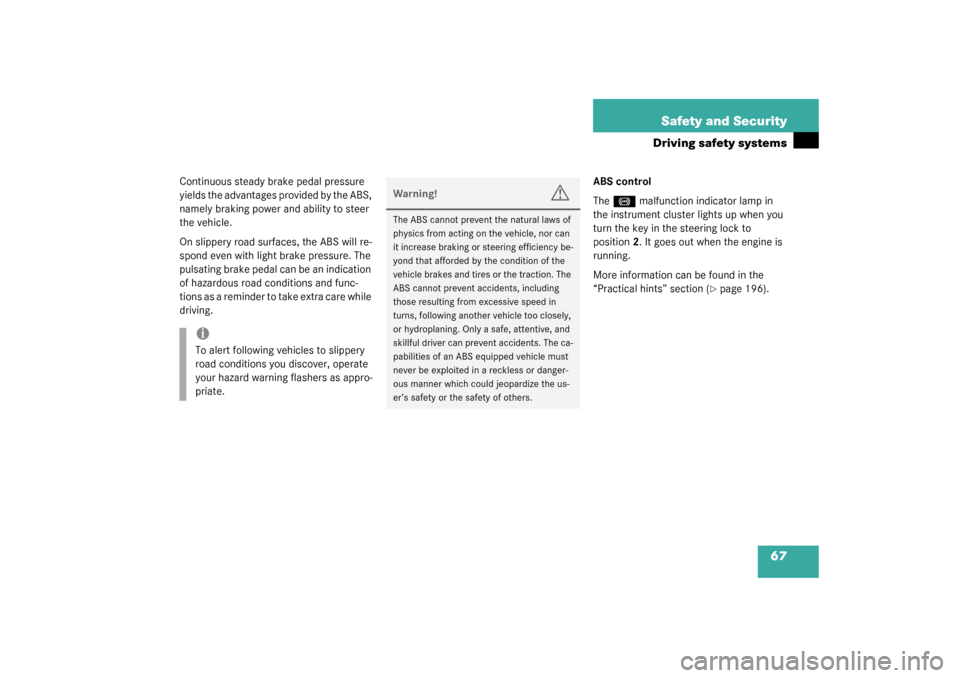
67 Safety and Security
Driving safety systems
Continuous steady brake pedal pressure
yields the advantages provided by the ABS,
namely braking power and ability to steer
the vehicle.
On slippery road surfaces, the ABS will re-
spond even with light brake pressure. The
pulsating brake pedal can be an indication
of hazardous road conditions and func-
tions as a reminder to take extra care while
driving.ABS control
The
-
malfunction indicator lamp in
the instrument cluster lights up when you
turn the key in the steering lock to
position2. It goes out when the engine is
running.
More information can be found in the
“Practical hints” section (
�page 196).
iTo alert following vehicles to slippery
road conditions you discover, operate
your hazard warning flashers as appro-
priate.
Warning!
G
The ABS cannot prevent the natural laws of
physics from acting on the vehicle, nor can
it increase braking or steering efficiency be-
yond that afforded by the condition of the
vehicle brakes and tires or the traction. The
ABS cannot prevent accidents, including
those resulting from excessive speed in
turns, following another vehicle too closely,
or hydroplaning. Only a safe, attentive, and
skillful driver can prevent accidents. The ca-
pabilities of an ABS equipped vehicle must
never be exploited in a reckless or danger-
ous manner which could jeopardize the us-
er’s safety or the safety of others.
Page 68 of 304
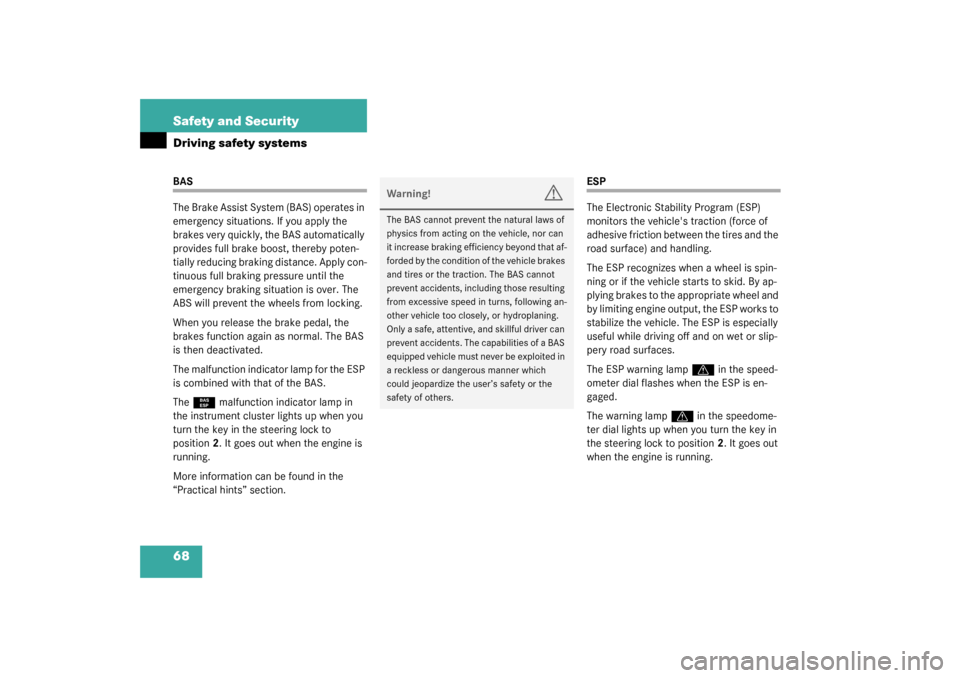
68 Safety and SecurityDriving safety systemsBAS
The Brake Assist System (BAS) operates in
emergency situations. If you apply the
brakes very quickly, the BAS automatically
provides full brake boost, thereby poten-
tially reducing braking distance. Apply con-
tinuous full braking pressure until the
emergency braking situation is over. The
ABS will prevent the wheels from locking.
When you release the brake pedal, the
brakes function again as normal. The BAS
is then deactivated.
The malfunction indicator lamp for the ESP
is combined with that of the BAS.
The
¿
malfunction indicator lamp in
the instrument cluster lights up when you
turn the key in the steering lock to
position2. It goes out when the engine is
running.
More information can be found in the
“Practical hints” section.
ESP
The Electronic Stability Program (ESP)
monitors the vehicle's traction (force of
adhesive friction between the tires and the
road surface) and handling.
The ESP recognizes when a wheel is spin-
ning or if the vehicle starts to skid. By ap-
plying brakes to the appropriate wheel and
by limiting engine output, the ESP works to
stabilize the vehicle. The ESP is especially
useful while driving off and on wet or slip-
pery road surfaces.
The ESP warning lamp
v
in the speed-
ometer dial flashes when the ESP is en-
gaged.
The warning lamp
v
in the speedome-
ter dial lights up when you turn the key in
the steering lock to position2. It goes out
when the engine is running.
Warning!
G
The BAS cannot prevent the natural laws of
physics from acting on the vehicle, nor can
it increase braking efficiency beyond that af-
forded by the condition of the vehicle brakes
and tires or the traction. The BAS cannot
prevent accidents, including those resulting
from excessive speed in turns, following an-
other vehicle too closely, or hydroplaning.
Only a safe, attentive, and skillful driver can
prevent accidents. The capabilities of a BAS
equipped vehicle must never be exploited in
a reckless or dangerous manner which
could jeopardize the user’s safety or the
safety of others.
Page 70 of 304
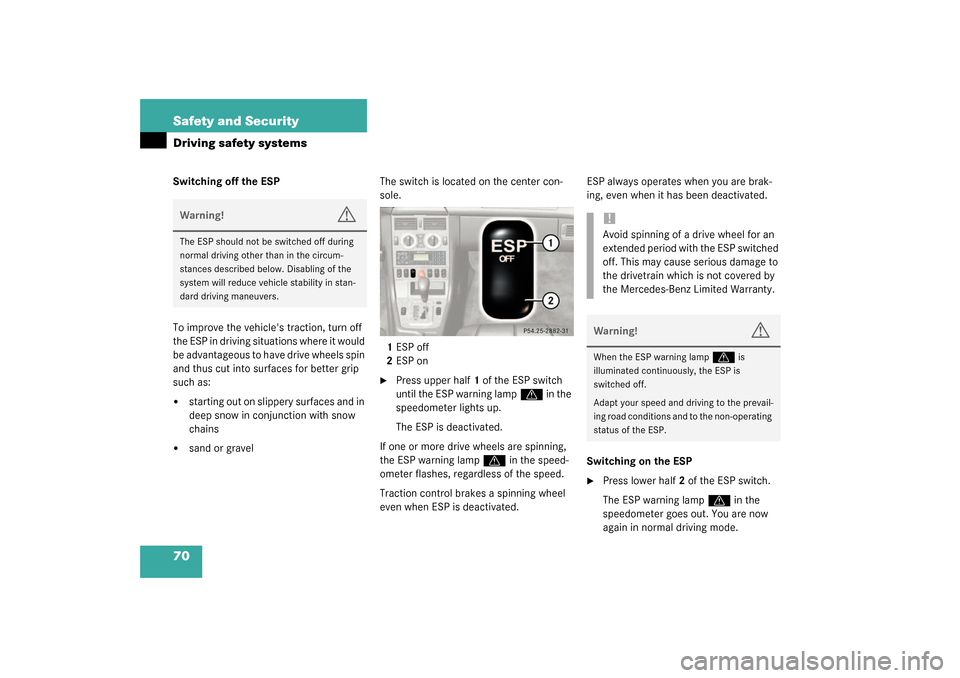
70 Safety and SecurityDriving safety systemsSwitching off the ESP
To improve the vehicle's traction, turn off
the ESP in driving situations where it would
be advantageous to have drive wheels spin
and thus cut into surfaces for better grip
such as:�
starting out on slippery surfaces and in
deep snow in conjunction with snow
chains
�
sand or gravelThe switch is located on the center con-
sole.
1ESP off
2ESP on
�
Press upper half1 of the ESP switch
until the ESP warning lamp
v
in the
speedometer lights up.
The ESP is deactivated.
If one or more drive wheels are spinning,
the ESP warning lamp
v
in the speed-
ometer flashes, regardless of the speed.
Traction control brakes a spinning wheel
even when ESP is deactivated.ESP always operates when you are brak-
ing, even when it has been deactivated.
Switching on the ESP
�
Press lower half2 of the ESP switch.
The ESP warning lamp
v
in the
speedometer goes out. You are now
again in normal driving mode.
Warning!
G
The ESP should not be switched off during
normal driving other than in the circum-
stances described below. Disabling of the
system will reduce vehicle stability in stan-
dard driving maneuvers.
!Avoid spinning of a drive wheel for an
extended period with the ESP switched
off. This may cause serious damage to
the drivetrain which is not covered by
the Mercedes-Benz Limited Warranty.Warning!
G
When the ESP warning lamp
v
is
illuminated continuously, the ESP is
switched off.
Adapt your speed and driving to the prevail-
ing road conditions and to the non-operating
status of the ESP.
Page 72 of 304
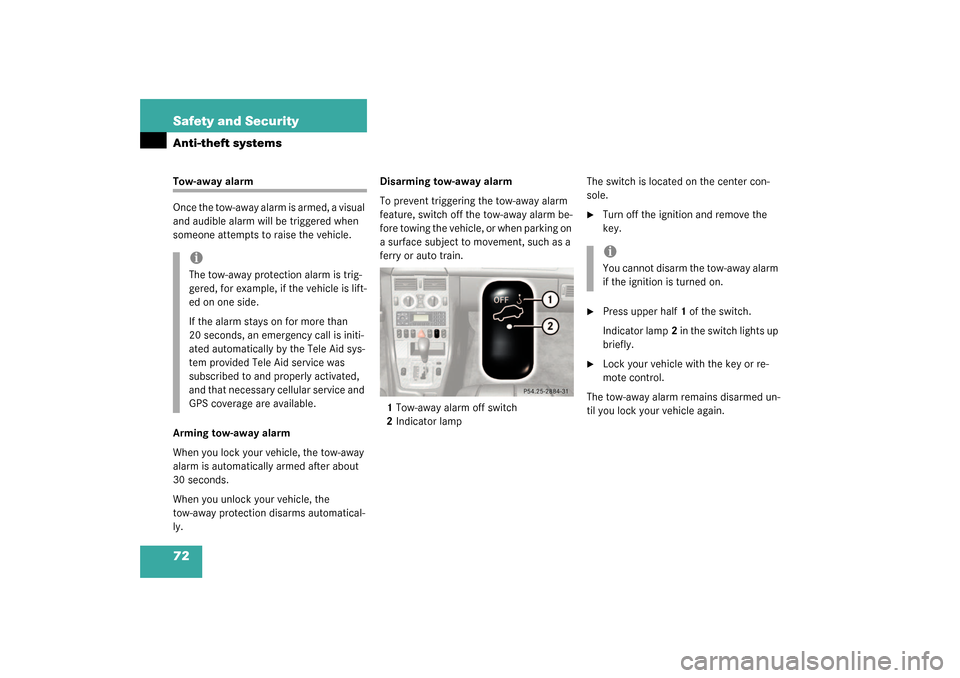
72 Safety and SecurityAnti-theft systemsTow-away alarm
Once the tow-away alarm is armed, a visual
and audible alarm will be triggered when
someone attempts to raise the vehicle.
Arming tow-away alarm
When you lock your vehicle, the tow-away
alarm is automatically armed after about
30 seconds.
When you unlock your vehicle, the
tow-away protection disarms automatical-
ly.Disarming tow-away alarm
To prevent triggering the tow-away alarm
feature, switch off the tow-away alarm be-
fore towing the vehicle, or when parking on
a surface subject to movement, such as a
ferry or auto train.
1Tow-away alarm off switch
2Indicator lampThe switch is located on the center con-
sole.
�
Turn off the ignition and remove the
key.
�
Press upper half1 of the switch.
Indicator lamp2 in the switch lights up
briefly.
�
Lock your vehicle with the key or re-
mote control.
The tow-away alarm remains disarmed un-
til you lock your vehicle again.
iThe tow-away protection alarm is trig-
gered, for example, if the vehicle is lift-
ed on one side.
If the alarm stays on for more than
20 seconds, an emergency call is initi-
ated automatically by the Tele Aid sys-
tem provided Tele Aid service was
subscribed to and properly activated,
and that necessary cellular service and
GPS coverage are available.
iYou cannot disarm the tow-away alarm
if the ignition is turned on.
Page 73 of 304
73 Controls in detail
Locking and unlocking
Seats
Lighting
Instrument cluster
Manual transmission
Automatic transmission*
Good visibility
Climate control
Audio system
Power windows
Retractable hardtop
Driving systems
Useful features
Page 76 of 304
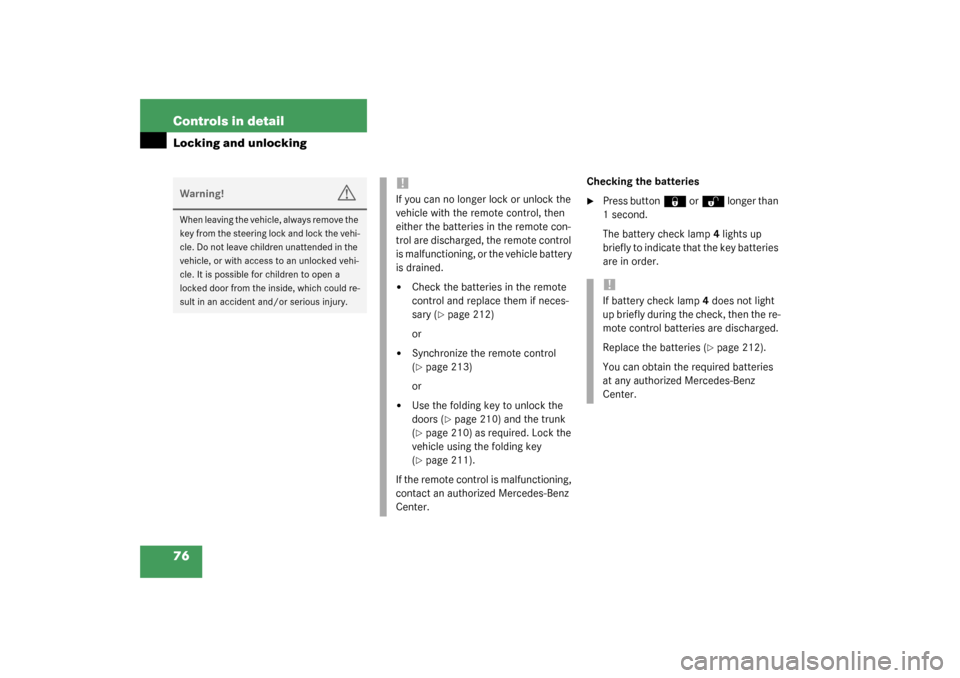
76 Controls in detailLocking and unlocking
Checking the batteries�
Press button
‹
or
Œ
longer than
1second.
The battery check lamp4 lights up
briefly to indicate that the key batteries
are in order.
Warning!
G
When leaving the vehicle, always remove the
key from the steering lock and lock the vehi-
cle. Do not leave children unattended in the
vehicle, or with access to an unlocked vehi-
cle. It is possible for children to open a
locked door from the inside, which could re-
sult in an accident and/or serious injury.
!If you can no longer lock or unlock the
vehicle with the remote control, then
either the batteries in the remote con-
trol are discharged, the remote control
is malfunctioning, or the vehicle battery
is drained.�
Check the batteries in the remote
control and replace them if neces-
sary (
�page 212)
or
�
Synchronize the remote control
(�page 213)
or
�
Use the folding key to unlock the
doors (
�page 210) and the trunk
(
�page 210) as required. Lock the
vehicle using the folding key
(�page 211).
If the remote control is malfunctioning,
contact an authorized Mercedes-Benz
Center.
!If battery check lamp4 does not light
up briefly during the check, then the re-
mote control batteries are discharged.
Replace the batteries (
�page 212).
You can obtain the required batteries
at any authorized Mercedes-Benz
Center.
Page 79 of 304
79 Controls in detail
Locking and unlocking
Individual setting
You can deactivate the automatic central
locking. The central locking switch is locat-
ed on the upper center console.Central locking switch1Locking
2Unlocking
�
Check that the ignition is switched on.
All the lamps in the instrument cluster
light up.
�
Press and hold lower part2 of the cen-
tral locking switch for approximately
5seconds.
The automatic central locking is deacti-
vated.Restoring to factory setting
�
Check that the ignition is switched on.
All the lamps in the instrument cluster
light up.
�
Press and hold upper part1 of the cen-
tral locking switch for approximately
5seconds.
The automatic central locking is acti-
vated.
Page 81 of 304
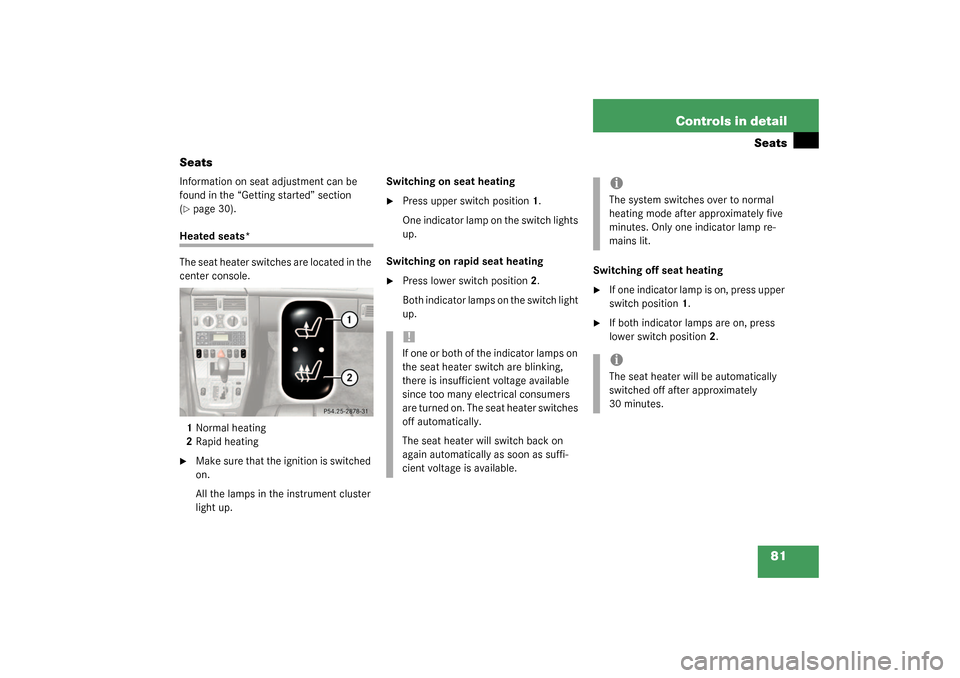
81 Controls in detail
Seats
Seats
Information on seat adjustment can be
found in the “Getting started” section
(�page 30).
Heated seats*
The seat heater switches are located in the
center console.
1Normal heating
2Rapid heating�
Make sure that the ignition is switched
on.
All the lamps in the instrument cluster
light up.Switching on seat heating
�
Press upper switch position1.
One indicator lamp on the switch lights
up.
Switching on rapid seat heating
�
Press lower switch position2.
Both indicator lamps on the switch light
up.Switching off seat heating
�
If one indicator lamp is on, press upper
switch position1.
�
If both indicator lamps are on, press
lower switch position2.
!If one or both of the indicator lamps on
the seat heater switch are blinking,
there is insufficient voltage available
since too many electrical consumers
are turned on. The seat heater switches
off automatically.
The seat heater will switch back on
again automatically as soon as suffi-
cient voltage is available.
iThe system switches over to normal
heating mode after approximately five
minutes. Only one indicator lamp re-
mains lit. iThe seat heater will be automatically
switched off after approximately
30 minutes.